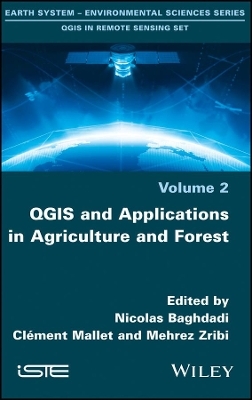
QGIS and Applications in Agriculture and Forest
ISTE Ltd and John Wiley & Sons Inc (Verlag)
978-1-78630-188-8 (ISBN)
Nicolas Baghdadi, French Research Institute of Science and Technology for Environment and Agriculture, France Mehrez Zribi, CNRS and CESBIO, France Clément Maillet, ING, France
Introduction xi
Chapter 1 Coupling Radar and Optical Data for Soil Moisture Retrieval over Agricultural Areas 1
Mohammad El Hajj, Nicolas Baghdadi, Mehrez Zribi And Hassan Bazzi
1.1 Context 1
1.2 Study site and satellite data 2
1.2.1 Radar images 2
1.2.2 Optical image 4
1.2.3 Land cover map 4
1.3 Methodology 5
1.3.1. Inversion approach of radar signal for estimating soil moisture 5
1.3.2 Segmentation of crop and grasslands areas 6
1.3.3 Soil moisture mapping 8
1.4 Implementation of the application via QGIS 10
1.4.1 Layout 10
1.4.2 Radar images 14
1.4.3 Optical image 20
1.4.4 Land cover map 26
1.4.5 Segmentation of crop’s areas and grasslands 26
1.4.6 Elimination of small spatial units 29
1.4.7 Mapping soil moisture 33
1.4.8 Soil moisture maps 43
1.5 Bibliography 44
Chapter 2 Disaggregation of Thermal Images 47
Mar Bisquert and Juan Manuel Sánchez
2.1 Definition and context 47
2.2 Disaggregation method 48
2.2.1 Image pre-processing 48
2.2.2 Disaggregation 50
2.3 Practical application of the disaggregation method 53
2.3.1 Input data 53
2.3.2 Step 1: pre-processing 54
2.3.3 Step 2: disaggregation 63
2.4 Results analysis 73
2.5 Bibliography 75
Chapter 3 Automatic Extraction of Agricultural Parcels from Remote Sensing Images and the RPG Database with QGIS/OTB 77
Jean-Marc Gilliot, Camille Le Priol, Emmanuelle Vaudour and Philippe MARTIN
3.1 Context 77
3.2 Method of AP extraction 79
3.2.1 Formatting the RPG data 79
3.2.2 Classification of SPOT satellite images 81
3.2.3. Intersect overlay between extracted AP and FB with crop validation 81
3.3 Practical application of the AP extraction 82
3.3.1 Software and data 83
3.3.2 Setting up the Python script 86
3.3.3 Step 1: formatting the RPG data 89
3.3.4 Step 2: classification of SPOT satellite Images 97
3.3.5 Step 3: intersect overlay between extracted AP and FB and crop validation 110
3.4 Acknowledgements 116
3.5 Bibliography 116
Chapter 4 Land Cover Mapping Using Sentinel-2 Images and the Semi-Automatic Classification Plugin: A Northern Burkina Faso Case Study 119
Louise Leroux, Luca Congedo, Beatriz Bellón, Raffaele Gaetano and Agnès Bégué
4.1 Context 119
4.2 Workflow for land cover mapping 120
4.2.1 Introduction to SCP and S2 images 120
4.2.2 Pre-processing 122
4.2.3 Land cover classification 126
4.2.4 Classification accuracy assessment and post-processing 129
4.3 Implementation with QGIS and the plugin SCP 131
4.3.1 Software and data 131
4.3.2 Step 1: data pre-processing 133
4.3.3 Step 2: land cover classification 139
4.3.4. Step 3: assessment of the classification accuracy and post-processing 144
4.4 Bibliography 150
Chapter 5 Detection and Mapping of Clear-Cuts with Optical Satellite Images 153
Kenji Ose
5.1 Definition and context 153
5.2 Clear-cuts detection method 154
5.2.1 Step 1: change detection – geometric and radiometric pre-processing 154
5.2.2 Steps 2 and 3: forest delimitation 160
5.2.3 Step 4: clear-cuts classification 160
5.2.4 Steps 5 and 6: export in vector mode 162
5.2.5 Step 7: statistical evaluation 164
5.2.6 Method limits 166
5.3 Practical application 166
5.3.1 Software and data 166
5.3.2 Step 1: creation of the changes image 168
5.3.3 Steps 2 and 3: creation, merging and integration of masks 170
5.3.4 Step 4: clear-cuts detection 174
5.3.5 Step 5: vector conversion 177
5.4 Bibliography 180
Chapter 6 Vegetation Cartography from Sentinel-1 Radar Images 181
Pierre-Louis Frison and Cédric Lardeux
6.1 Definition and context 181
6.2 Classification of remote sensing images 183
6.3 Sentinel-1 data processing 185
6.3.1 Radiometric calibration 186
6.3.2 Ortho-rectification of calibrated data 186
6.3.3 Clip over a common area 187
6.3.4 Filtering to reduce the speckle effect 187
6.3.5. Generation of color compositions based on different polarizations 188
6.4 Implementation of the processing within QGIS 189
6.4.1 Downloading data 194
6.4.2 Calibration, ortho-rectification and stacking of Sentinel-1 data over a common area 198
6.4.3 Speckle filtering 201
6.4.4 Other tools 202
6.5 Data classification 205
6.6 Bibliography 212
Chapter 7 Remote Sensing of Distinctive Vegetation in Guiana Amazonian Park 215
Nicolas Karasiak and Pauline Perbet
7.1 Context and definition 215
7.1.1 Global context 215
7.1.2 Species 216
7.1.3 Remote sensing images available 217
7.1.4 Software 219
7.1.5 Method implementation 219
7.2 Software installation 220
7.2.1 Dependencies installation available in OsGeo 220
7.2.2 Installation of scikit-learn 221
7.2.3 Dzetsaka installation 222
7.3 Method 222
7.3.1 Image processing 223
7.3.2 Cloud mask creation 225
7.4 Processing 227
7.4.1 Creating training plots 227
7.4.2 Classification with dzetsaka plugin 230
7.4.3 Post-classification 236
7.5 Final processing 239
7.5.1 Synthesis of predicted images 240
7.5.2 Global synthesis and cleaning unwanted areas 242
7.5.3 Statistical validation – limits 244
7.6 Conclusion 245
7.7 Bibliography 245
Chapter 8 Physiognomic Map of Natural Vegetation 247
Samuel Alleaume and Sylvio Laventure
8.1 Context 247
8.2 Method 247
8.2.1 Segmentation of the VHSR mono-date image 249
8.2.2 Calculation of temporal variability indices 249
8.2.3 Extraction of natural vegetation using time series 251
8.2.4 Vegetation densities 252
8.2.5 Maximum productivity index of herbaceous areas 255
8.3 Implementation of the application 256
8.3.1 Study area 256
8.3.2 Software and data 257
8.3.3 Step 1: VHSR image processing 259
8.3.4 Step 2: calculation of the variability indices on the time series 264
8.3.5 Step 3: extraction of the natural vegetations from the time series of Sentinel-2 image by thresholding method 267
8.3.6 Step 4: classification of vegetation density by supervised classification SVM 274
8.3.7 Step 5: extraction of the level of productivity of grasslands 277
8.3.8 Step 6: final map 279
8.4 Bibliography 282
Chapter 9 Object-Based Classification for Mountainous Vegetation Physiognomy Mapping 283
Vincent Thierion and Marc Lang
9.1 Definition and context 283
9.2 Method for detecting montane vegetation physiognomy 284
9.2.1 Satellite image pre-processing 286
9.2.2 Image segmentation 289
9.2.3 Sampling, learning and segmented image classification 291
9.2.4 Statistical validation of classification 295
9.2.5 Limits of the method 297
9.3 Application in QGIS 298
9.3.1 Pre-processing 299
9.3.2 Segmentation 312
9.3.3 Classification 319
9.4 Bibliography 337
List of Authors 341
Index 343
Scientific Committee 347
| Erscheinungsdatum | 24.01.2018 |
|---|---|
| Verlagsort | London |
| Sprache | englisch |
| Maße | 163 x 236 mm |
| Gewicht | 658 g |
| Themenwelt | Mathematik / Informatik ► Informatik ► Office Programme |
| Naturwissenschaften ► Geowissenschaften ► Geografie / Kartografie | |
| ISBN-10 | 1-78630-188-1 / 1786301881 |
| ISBN-13 | 978-1-78630-188-8 / 9781786301888 |
| Zustand | Neuware |
| Informationen gemäß Produktsicherheitsverordnung (GPSR) | |
| Haben Sie eine Frage zum Produkt? |
aus dem Bereich


